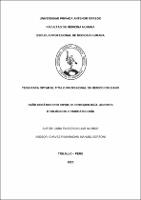Mostrar el registro sencillo del ítem
Daño hepático por COVID-19: epidemiologia, agentes etiológicos y fisiopatología
| dc.contributor.advisor | Chavez Rimarachin, Manuel Bertoni | |
| dc.contributor.author | Cuba Plasencia, Luis Alonso | |
| dc.creator | Cuba Plasencia, Luis Alonso | |
| dc.date.accessioned | 2020-09-11T21:50:11Z | |
| dc.date.available | 2020-09-11T21:50:11Z | |
| dc.date.issued | 2020 | |
| dc.identifier.uri | https://hdl.handle.net/20.500.12759/6533 | |
| dc.description.abstract | En diciembre del 2019 se originó un brote de infección en Wuhan (China) de un nuevo tipo de coronavirus, el cual fue llamado SARS-CoV-2, agente viral causante de la COVID-19 (Enfermedad del coronavirus 2019). Esta enfermedad fue declarada como una emergencia sanitaria a nivel internacional por la OMS. El pulmón es el órgano principalmente afectado por la COVID-19, sin embargo en base a una revisión completa y detallada de la literatura actual se han detectado lesiones hepáticas generalmente en estados severos de la enfermedad que se manifestaron con alteración en los niveles séricos de los marcadores hepáticos, comúnmente en ausencia de comorbilidades hepáticas que pudieran alterar la analítica hepática. Los mecanismos que probablemente causaron esta injuria hepática fueron la infección directa del SARS-CoV al sistema hepatobiliar mediada por la ECA-2, falla multiorgánica en estado crítico, toxicidad por fármacos, estrés psicológico y/o la progresión de una enfermedad hepática preexistente; sin embargo, la fisiopatología y la etiología no se conocen con exactitud. Debido a esto se buscará analizar la epidemiología, agentes etiológicos y fisiopatología del daño hepático por la COVID-19, lo cual ampliará los conocimientos científicos de los profesionales de la salud para un manejo adecuado del paciente. | es_PE |
| dc.description.abstract | In December 2019, an outbreak of infection in Wuhan (China) originated from a new type of coronavirus, which was called SARS-CoV-2, a viral agent that causes COVID-19 (Coronavirus Disease 2019). This disease was declared an international health emergency by the WHO. The lung is the organ mainly affected by COVID-19, however, based on a complete and detailed review of the current literature, liver lesions have been detected generally in severe disease states that manifested with alteration in the serum levels of the liver markers, commonly in the absence of liver comorbidities that could alter liver testing. The mechanisms that probably caused this liver injury were the direct infection of the SARS-CoV to the hepatobiliary system mediated by ACE-2, multi-organ failure in a critical state, drug toxicity, psychological stress and/or the progression of a preexisting liver disease; however, the pathophysiology and etiology are not exactly known. Due to this, we will seek to analyze the epidemiology, etiological agents and pathophysiology of liver damage caused by COVID-19, which will expand the scientific knowledge of health professionals for proper patient management. | en_US |
| dc.description.uri | Tesis | es_PE |
| dc.format | application/pdf | es_PE |
| dc.language.iso | spa | es_PE |
| dc.publisher | Universidad Privada Antenor Orrego - UPAO | es_PE |
| dc.relation.ispartofseries | T_MED.HUMA_2826 | |
| dc.rights | info:eu-repo/semantics/openAccess | es_PE |
| dc.source | Universidad Privada Antenor Orrego | es_PE |
| dc.source | Repositorio Institucional - UPAO | es_PE |
| dc.subject | COVID-19 | es_PE |
| dc.subject | Daño hepático | es_PE |
| dc.title | Daño hepático por COVID-19: epidemiologia, agentes etiológicos y fisiopatología | es_PE |
| dc.type | info:eu-repo/semantics/bachelorThesis | es_PE |
| thesis.degree.level | Título Profesional | es_PE |
| thesis.degree.grantor | Universidad Privada Antenor Orrego. Facultad de Medicina Humana | es_PE |
| thesis.degree.name | Médico Cirujano | es_PE |
| thesis.degree.discipline | Medicina | es_PE |
Ficheros en el ítem
Este ítem aparece en la(s) siguiente(s) colección(es)
-
Medicina Humana [2720]

